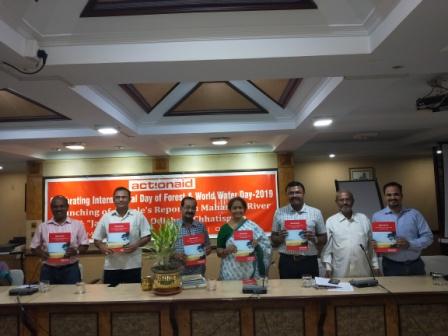Bhubaneswar: Action Aid in association with its partners launched the People’s Report on Mahanadi River and Jal Sathi Programme in Odisha at the state-level programme organised at CYSD office here Monday.
On the occasion more than 60 women leaders and youth volunteers including the Jal Sathi-water volunteers joined this programme and contributed to the discussion sharing their views and ideas related to the Mahanadi issue.
This report was the result of study undertaken in 10 Districts of Odisha and Chhattisgarh. The study covered 36 villages in 8 districts (Jharsuguda, Sambalpur, Subarnapur, Boudh, Angul, Nayagarh, Cuttack, Jagatsinghpur, Khorda and Puri) of Odisha and 4 villages in 2 districts (Raigarh and Jahangir Champa) of Chhattisgarh. The data collection was done through using a structured schedule and focused group discussion with different categories of the population in the villages along the river basin of the Mahanadi. Besides, the study has made an attempt to collect evidences in terms of collecting case studies from the field that reflect the vulnerabilities of the community from the Mahanadi.
About 60 community representatives from 12 districts (Nayagarh, Boudh, Angul, Cuttack, Subarnapur, Sambalpur, Jagatsinghpur, Jharsuguda, Puri, Khurda & Ganjam) of Odisha &and Jahangir Champa of Chhatisgarh joined this meeting and shared their views, issues and concerns. Also, people from CSO, leaders of people’s organization, lawyers and environmentalists have been invited to share their views.
The Regional Manager of ActionAid, Debabrat Patra, said that the natural flow of the river is vital for protection of the traditional livelihoods of many communities living on the river basin of Mahanadi. There should be collective efforts to protect the river and the government has a great role to play since the livelihoods of many marginalised communities depend upon this.
Bimal Pandia, a development research and water expert said that the river is a living entity like a human being. There should be natural flow of water as blood flows in the vein of a living being. And, all our efforts should be on how to facilitate the natural flow of water to retain the river that in turn will restore the livelihoods of many marginalized communities.
Priyabarata Satapathy, development researcher said that the industrial and medical wastes are the major sources of pollution of water in Mahanadi. The rights to natural flow of water need to be protected.
B N Durga of ActionAid, said both State Governments of Odisha and Chhattisgarh are mostly concerned about the water demand by industries and intend to establish more industries and provide them water. They are least concerned about water demand by farmers, fishermen, artisans or in maintaining minimum environmental flow in the river.
As per report, 87 percent people used Mahanadi river for fishing purpose as most communities depend upon fishing as their primary livelihood option. Almost 77 per cent villages used it for irrigation purpose. 37 percent people use river water for drinking purpose. 32 percent are using it for navigation and 57 percent for cultural use. Communities from Chhattisgarh are using only for irrigation and fishing which is now again not possible as they have less access to water after construction of barrages.
Over last four to five years, communities have experienced a shift in the pattern of river water use. The overall scenario depicts that there is less water for irrigation purpose, hardly any fish to catch throughout the year, no food for last few years and increased pollution level.
Around 82 per cent people stated that there is less water available for irrigation. Some stated that because there have been no floods in last few years the top soil deposit which makes the land more fertile, is absent. River basin communities are affected as they lost their livelihood as they cannot go fishing. Now they are only able to catch fish in rainy season and forced to alter their livelihood and most people migrate to other places in search of livelihood.







































